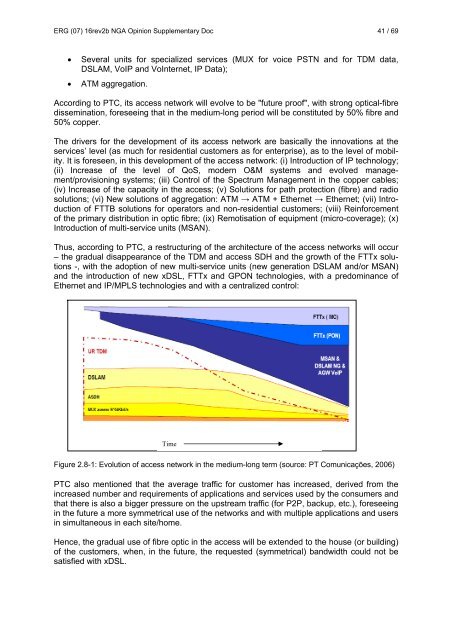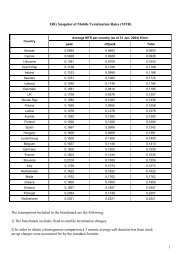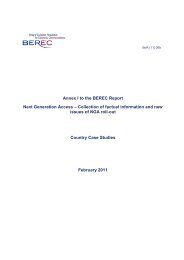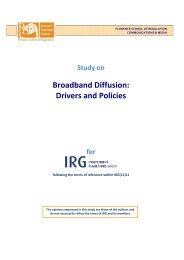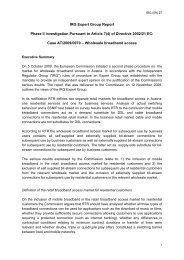16 Rev2b NGA Opinion Supplementary doc - IRG
16 Rev2b NGA Opinion Supplementary doc - IRG
16 Rev2b NGA Opinion Supplementary doc - IRG
You also want an ePaper? Increase the reach of your titles
YUMPU automatically turns print PDFs into web optimized ePapers that Google loves.
ERG (07) <strong>16</strong>rev2b <strong>NGA</strong> <strong>Opinion</strong> <strong>Supplementary</strong> Doc 41 / 69<br />
• Several units for specialized services (MUX for voice PSTN and for TDM data,<br />
DSLAM, VoIP and VoInternet, IP Data);<br />
• ATM aggregation.<br />
According to PTC, its access network will evolve to be "future proof", with strong optical-fibre<br />
dissemination, foreseeing that in the medium-long period will be constituted by 50% fibre and<br />
50% copper.<br />
The drivers for the development of its access network are basically the innovations at the<br />
services’ level (as much for residential customers as for enterprise), as to the level of mobility.<br />
It is foreseen, in this development of the access network: (i) Introduction of IP technology;<br />
(ii) Increase of the level of QoS, modern O&M systems and evolved management/provisioning<br />
systems; (iii) Control of the Spectrum Management in the copper cables;<br />
(iv) Increase of the capacity in the access; (v) Solutions for path protection (fibre) and radio<br />
solutions; (vi) New solutions of aggregation: ATM → ATM + Ethernet → Ethernet; (vii) Introduction<br />
of FTTB solutions for operators and non-residential customers; (viii) Reinforcement<br />
of the primary distribution in optic fibre; (ix) Remotisation of equipment (micro-coverage); (x)<br />
Introduction of multi-service units (MSAN).<br />
Thus, according to PTC, a restructuring of the architecture of the access networks will occur<br />
– the gradual disappearance of the TDM and access SDH and the growth of the FTTx solutions<br />
-, with the adoption of new multi-service units (new generation DSLAM and/or MSAN)<br />
and the introduction of new xDSL, FTTx and GPON technologies, with a predominance of<br />
Ethernet and IP/MPLS technologies and with a centralized control:<br />
Time<br />
Figure 2.8-1: Evolution of access network in the medium-long term (source: PT Comunicações, 2006)<br />
PTC also mentioned that the average traffic for customer has increased, derived from the<br />
increased number and requirements of applications and services used by the consumers and<br />
that there is also a bigger pressure on the upstream traffic (for P2P, backup, etc.), foreseeing<br />
in the future a more symmetrical use of the networks and with multiple applications and users<br />
in simultaneous in each site/home.<br />
Hence, the gradual use of fibre optic in the access will be extended to the house (or building)<br />
of the customers, when, in the future, the requested (symmetrical) bandwidth could not be<br />
satisfied with xDSL.


